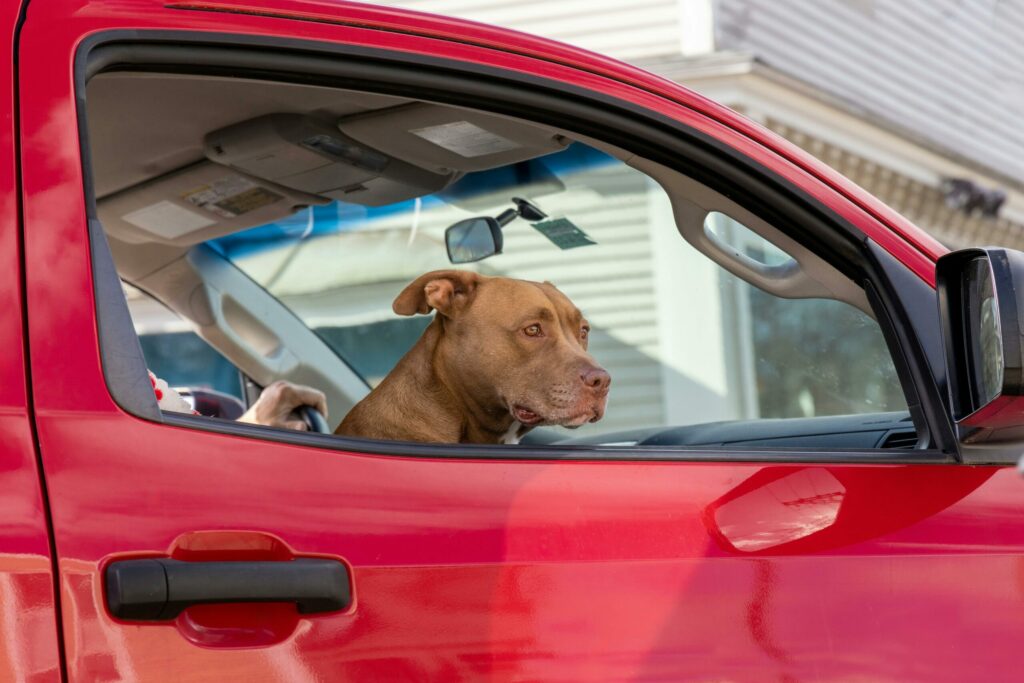Heat stroke in pets, also known as hyperthermia, occurs when a dog’s body temperature rises to dangerous levels due to prolonged exposure to high temperatures or strenuous physical activity in hot weather. Heat stroke is a serious condition that can be life-threatening if not promptly treated.
Cause of Heat Stroke in our fur babies
Heat stroke can occur when a pet is exposed to high temperatures, especially in environments with limited ventilation or shade. It can also happen when a pet is left in a parked car, even for a short period, as temperatures inside a car can quickly rise to dangerous levels, leading to heat stroke. Additionally, certain breeds with short noses (brachycephalic breeds) or thick fur are more susceptible to heat stroke.
- High Temperatures: Exposure to high temperatures, especially during hot and humid weather, can lead to heat stroke in dogs. This can occur when dogs are left outdoors without access to shade or water, or when they are confined in enclosed spaces with limited ventilation, such as cars or poorly ventilated rooms.
- Strenuous Exercise: Intense physical activity, such as running, playing fetch, or strenuous workouts, can cause dogs to overheat and develop heat stroke, particularly if the activity occurs during hot weather or in direct sunlight. Brachycephalic breeds (dogs with short noses) and dogs with thick coats are particularly susceptible to heat stroke during exercise.
- Confinement in Cars: Leaving dogs unattended in parked cars, even for a short period, can quickly lead to heat stroke. Temperatures inside a car can rise rapidly, even with the windows cracked open, posing a significant risk of overheating and heat stroke.
- Poor Ventilation: Dogs kept in poorly ventilated areas, such as kennels, crates, or poorly ventilated rooms, may be at increased risk of heat stroke, especially if temperatures are high and there is limited airflow.
- Age and Health Factors: Elderly dogs, puppies, and dogs with pre-existing health conditions are more susceptible to heat stroke. Conditions such as obesity, heart disease, respiratory problems, and thick fur can increase the risk of overheating and heat stroke.
- Lack of Access to Water: Dehydration can contribute to heat stroke in dogs. If dogs do not have access to fresh, clean water, they may become dehydrated, making it more difficult for them to regulate their body temperature and cool down effectively.
Signs of Heat Stroke in our fur babies
- Excessive panting
- Rapid breathing
- Drooling
- Bright red gums
- Weakness
- Vomiting
- Diarrhea
- Collapse
- Seizures
- Unconsciousness
- In severe cases, heat stroke can cause organ failure and death.
Risk Factors of Heat Stroke
Factors that increase the risk of heat stroke in pets include hot and humid weather, lack of access to shade or water, being left in a parked car, obesity, old age, and underlying health conditions such as heart disease or respiratory problems.
How to Protect Your Fur Babies From Heat Stroke
Protecting your pets from heat stroke is crucial, especially during hot weather or when engaging in outdoor activities. Here are some tips to help prevent heat stroke in your pets:
Provide Ample Water: Always ensure that your pet has access to fresh, clean water, especially during hot weather. Hydration is essential for regulating body temperature and preventing heat-related illnesses.
Limit Outdoor Activities: Avoid strenuous exercise or outdoor activities during the hottest parts of the day, typically between 10 AM and 4 PM. Instead, opt for early morning or evening walks when temperatures are cooler.
Provide Shade and Shelter: If your pet spends time outdoors, make sure they have access to shaded areas where they can rest and cool off. Provide shelter from the sun, such as a covered patio or a doghouse, to protect them from direct sunlight.
Avoid Hot Surfaces: Hot pavement, sand, or concrete can burn your pet’s paw pads and contribute to overheating. Walk your pet on grass or shaded paths, and avoid hot surfaces during peak sun hours.
Never Leave Pets in Cars: Never leave your pet unattended in a parked car, even for a short period. Cars can quickly heat up to dangerous temperatures, even with the windows cracked open, leading to heat stroke and death.
Monitor for Signs of Overheating: Learn to recognize the signs of heat stroke in pets, including excessive panting, drooling, rapid heartbeat, weakness, vomiting, and collapse. If you suspect your pet is overheating, move them to a cooler area immediately and seek veterinary attention.
Provide Cooling Measures: Offer your pet cooling options such as a damp towel to lay on, a fan, or a cooling mat. You can also use a spray bottle to mist your pet with cool water or allow them to swim in a shallow pool or kiddie pool.
Trim Long Fur: If your pet has long fur, consider trimming it to a shorter length during the summer months to help them stay cooler. However, avoid shaving your pet’s fur too short, as it can leave them susceptible to sunburn and skin irritation.
Watch for Breed Susceptibility: Some breeds, such as brachycephalic breeds (e.g., Bulldogs, Pugs) and dogs with thick coats, are more prone to heat stroke due to their anatomy. Take extra precautions with these breeds and monitor them closely in hot weather.
Consult Your Veterinarian: If you have concerns about your pet’s ability to handle hot weather or if they have underlying health conditions, consult your veterinarian for personalized advice and recommendations on how to keep them safe and comfortable during hot weather.
By following these tips and being vigilant about your pet’s well-being during hot weather, you can help protect them from heat stroke and ensure they stay healthy and happy.









